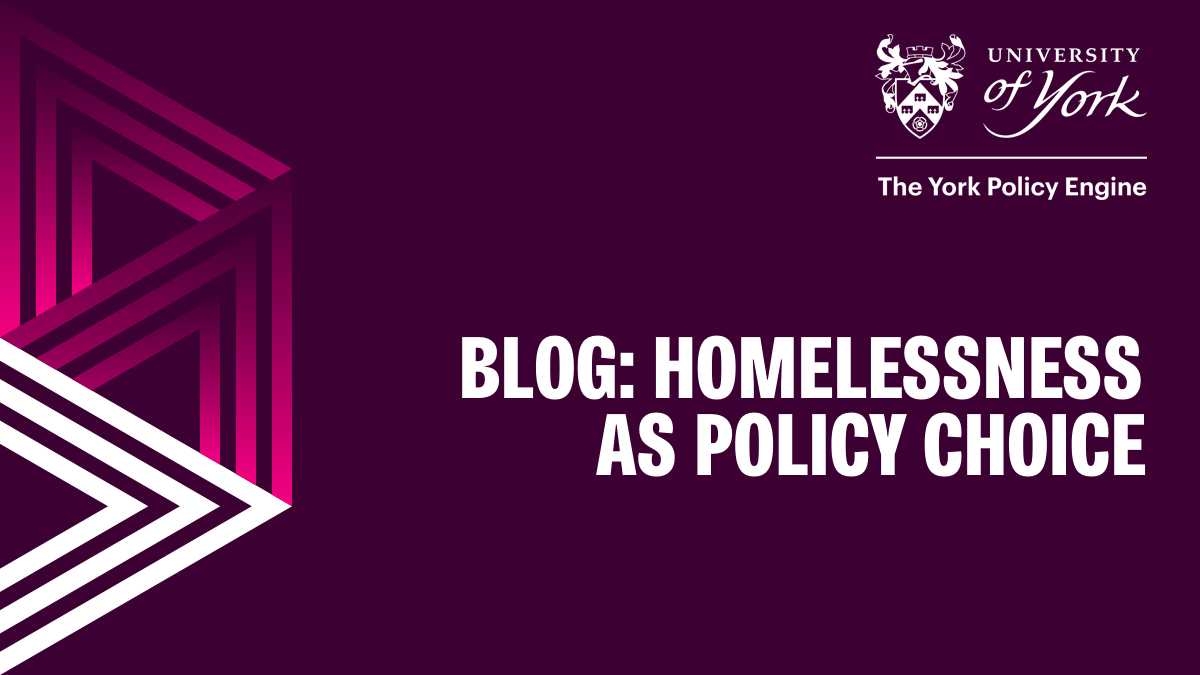Blog: Homelessness as a Policy Choice by Nicholas Pleace and Carolyn Snell
Nicholas Pleace and Carolyn Snell explore austerity, the cost of living crisis and the weakening of the homelessness sector

Thirty-seven of England’s leading homelessness charities and service providers wrote to the Chancellor of the Exchequer on 27th February to inform him that many homelessness services are at the point of collapse. This news just preceded two announcements on 29th February, that rough sleeping had increased by 27% in England while homeless households in temporary accommodation had reached the highest level ever recorded. Billions are being spent on the effects of homelessness each year in England, so how has such a desperate failure of policy occurred?
This has been a long process. The beginnings are in 1980, when Thatcherism sold much of the existing social (council) housing to tenants at a substantial discount, effectively removed the ability from councils to build new social homes and from 1988, began to privatise the finances of housing associations so they were forced to mainly build (not very) ‘affordable’ homes. Spending shifted to housing benefit so that lower income people who no longer had the option of social housing, including some employed households could rent privately. Housing supply became inelastic so that even recessions and crashes did little to slow rising private sector rents and house prices.
The last gasp of social democratic English housing policy, the 1977 Housing (Homeless Persons) Act had been a breakthrough. Much amended since, it established duties on local housing authorities to provide permanent homes for people experiencing homelessness who had dependent children with them, who were escaping domestic abuse and who had a ‘vulnerability’ that would be exacerbated by homelessness.
The Act had assumed that one third of UK housing stock was social and homelessness could be comfortably dealt with by creating priority need access to that housing, there still being plenty (because of course more would be built) to deal with other housing needs. In 1980, before England stopped building social housing at scale and started selling existing stock under the Right to Buy (which was never extended to private rented sector tenants), there were around 4,700 homeless households in temporary accommodation, at the last (not very recent) statistical bulletin, there were 105,750 households containing 138,930 children. That’s around a 2,245% increase, which is now costing some £1.7bn a year. Data just released put the numbers at 142,490 children in 109,000 households in temporary accommodation in the Autumn of last year, the costs of which are yet to be determined.
Homelessness prevention was intensified around 2005, reducing temporary accommodation numbers from 100,000 to 48,000 by 2011, but then went back up again, reaching 73,000 by 2016. Prevention was tried again with the 2017 Homelessness Reduction Act, although this time it did not work and temporary accommodation levels remained high.
Temporary accommodation use and overall levels of homelessness, has continued to rise for three reasons: no meaningful increase in affordable homes and continued loss of social housing which meant people experiencing homelessness became semi-permanently stuck in temporary accommodation; the impact of austerity bringing many people reliant on benefits into situations of net negative income and the impact of deep cuts across every aspect of social and health policy across England.
York’s wider research on the cost of living crisis and our recent work on fuel poverty and homelessness has shown how depleted public, voluntary and community services lack the resources to fully respond to the effects of a sudden spike in poverty within what is now a deeply unequal society. Our work highlights how homelessness services, which had seen public expenditure fall in their sector by over £1bn since 2010 and are facing inadequate, falling and highly unstable funding environments, after battling COVID-19, have no more defences against sudden surges in energy and other living costs than the people experiencing homelessness they were seeking to help. Energy costs threatened to reduce some services and close others. Effective services like Housing First broke down because rehoused people with complex needs could not afford to heat their homes. Homelessness services’ own staff are also struggling to manage. Local authorities could not help, as other York research shows, they are struggling to deliver basic services and at risk of bankruptcy because of the cost of living crisis, including funding increases in temporary accommodation, their budgets having fallen by 27% since 2010.
Our research on homelessness and fuel poverty, alongside other analysis, shows how the triggers for homelessness have multiplied. Poverty has been driven up by a deregulated, insecure, low wage labour market, by a refusal to pay sufficient levels of welfare benefits and by harsh, performative and evidence-free policy to force people into work that they either cannot actually do, or which is just not there. Housing markets are broken and completely dysfunctional, there are nothing like enough usable homes in England. People at risk of homelessness due to high and complex needs are, like the general population, faced by an NHS so depleted of resources it is struggling to function. The homeless sector was underfunded, precarious and shrinking before the cost of living crisis hit and now the situation has reached crisis point. Now even the last line of defence, homelessness services themselves, are beginning to finally collapse. This did not just happen. The cost of living crisis might be partially external in origin, what is happening now is a policy-driven disaster.
Professor Nicholas Pleace is a Professor of Social Policy in the Centre for Housing Policy at the University of York
Professor Carolyn Snell is a Professor of Social Policy in the School for Business and Society at the University of York